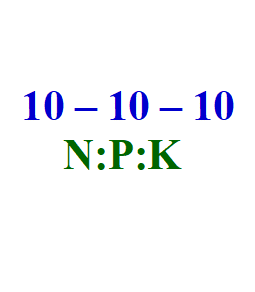
What is 10 10 10 Fertilizer, Actually?
For any avid gardener, understanding the fundamentals of fertilization is very important. There are a wide range of fertilizers that all serve a distinct purpose, and the 10-10-10 fertilizer stands out as one of the most prevalent choices. Its popular among both commercial and home gardeners and comes with plenty of advantages. This blog post, goes deep into the meaning of 10-10-10 fertilizer, and optimal usage.
When to use 10-10-10 Fertilizer
Now that we understand the roles of the individual N.P.K components, let’s explore how to make use of them.
This fertilizer blend is ideal for a wide range of garden- and houseplants as they enter and during the growth period, since require plenty of nutrients during this period.
Most garden and houseplant fertilizers have nitrogen as the largest component since it is very important for plants with green beautiful foliage to develop properly. Succulents and cacti have less green leaves and foliage and therefore require a more balanced fertilizer, quite often nitrogen is the smallest of the N.P.K components. When growing cacti, less nitrogen is the preferred choice.
What happens to plants when given too much Nitrogen Fertilizer?
Bare in mind, if the dosage of nitrogen is too large, may cause certain plants to disrupt the production of flower, fruit or berries. And instead grow an unusually large volume of leaves. And the plants may not produce flowers, berries or fruit until perhaps the following year or longer.
How to apply 10-10-10 Fertilizer in the garden?
The most common method is applying the fertilizer into the soil, suitable for both indoor and outdoor plants. Depending on your plant’s fertilization needs, you can apply it in different ways. If used indoors, simply sprinkle some of the product into the potting soil before planting. In the outdoor garden, apply it directly to the soil.
Pot Application:
Maximum Quantity:
- Administer 1 teaspoon (5g) for every liter of soil or substrate.
Optimal Timing:
- Prior to the flowering period and post-harvest or pruning activities, aiming to offset nutrient losses.
- Usage is recommended when the plant exhibits signs of debilitation, such as growth challenges and unusual discolorations.
Application Method:
- Create a circle around the plant with an 8 cm distance from the stem to avert damage. Apply the product in the required amount and water until it begins to drain from the bottom of the pot.
Soil Application:
Maximum Quantity:
- Apply 2.5 tablespoons (50g) per square meter.
Optimal Timing:
- Preceding the flowering phase and following harvest or pruning events to counterbalance nutrient losses.
- Application is advised when the plant manifests weakness, like growth difficulties and anomalous discolorations.
Application Method:
- Refrain from application during the hottest times of the day; preferably, administer in the early morning or late afternoon. Form a circle around the plant with a 10 cm distance from the stem to avert harm. Apply the product in the necessary amount and water until the soil is thoroughly saturated.
Once the fertilizer is introduced to the soil, don’t forget to water it! Water facilitates the transport of nutrients to the plants, so ensure they receive an adequate supply when needed. As long as both sunlight and water are available, your plants should thrive splendidly.
